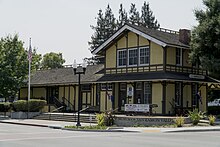User:Rbodner/sandbox
Overview[edit]
Located in Danville, California, the Museum of the San Ramon Valley is housed in what used to be a passenger-freight depot for the Southern Pacific Railroad and then a feed and grain store. The museum, which was founded as a non-profit organization in 1985, collects and preserves artifacts from the San Ramon Valley in addition to providing exhibits that display how the valley's environment and early settlers shaped the stories, institutions and cultures of our past and present society.[1]

History[edit]
Danville Depot[edit]
The Danville depot was one of four depots built to accommodate the Southern Pacific Railroad line. Completed on May 17, 1891, the new railroad traveled from Avon, CA to San Ramon, CA. After the line was built, four main depots were constructed and placed in Concord, Walnut Creek, San Ramon and Danville. The depots, which were built from the same standard construction design, were two-story buildings. The ground floor was made up of a lobby,luggage room, cargo room, and offices for a telegraph operator, ticket agent, and sometimes a Wells Fargo agent. The second floor, a two-bedroom apartment, was where the station agent lived. The railroad was in service from 1891 until 1978 when the train tracks were removed. [2]
Feed & Grain Store[edit]
In 1957, Joe Ramos and his father Joseph Ramos Sr., purchased the Danville depot building. It was out of this building that they ran the Danville Feed and Grain Store which they established in 1951. When the Ramos' started selling more household products to fit the needs of the community, which had started growing after World War II, they changed the business's name to Danville Feed and Garden Supply. After purchasing the building, the Ramos' painted the exterior walls red, but left the west exterior wall the original yellow.[3]
Museum[edit]
After Danville Feed and Garden Supply closed and the railroad tracks were removed, the Museum of the San Ramon Valley purchased the old depot, which by that point was the only surviving depot left. The museum then restored the depot to what they believe resembled its 1891 state; the exterior was repainted with yellow walls and brown trimming. After restoration, the building was moved 600 feet from its original location so as to incorporate it with the rest of the surrounding village. It now rests on the old rail road station land. Since its restoration, the depot has been listed as a Historic Place on the National Register of Historic Places and a Danville Heritage Resource building. [4]In addition to the depot building, the Museum of the San Ramon Valley also own and operates the town's old one room school house known as The Tassajara School House.[5]
Artifacts and Archives[edit]
The museum began collecting artifacts in 1970 and continues to do so today. Currently, the museum's archive holds biographical files, verbal stories, newspapers, maps, photographs, and other documents in addition to historic artifacts from or about the San Ramon Valley. Artifacts on permanent display include clothing, train tickets, artwork, and silverware. [6]
Exhibits[edit]
The permanent exhibit in the Museum of the San Ramon Valley features a historical narrative frieze, artifacts, and photographs. The exhibit focuses on the geology of the valley, the indigenous peoples that once lived on the land in addition to displays on the Rancho Period and the Gold Rush.[7]In addition to the permanent exhibit, the museum hosts temporary exhibits. Past exhibits have spotlighted topics like the lives of cattle ranchers and farmers in the San Ramon Valley [8], and the families of early inhabitants of the San Ramon area. As a result of the COVID-19 pandemic, the museum has no plans of opening a new temporary exhibit in the near future.[9]
Climate Change Impact[edit]
Over the past 10 years, the increasing fire hazards in California have threatened homes, business, galleries, and museums. Museum of the San Ramon Valley is no exception. There has been risks of fire evacuations in the Diablo Mountain area very near to the museum's location. As the global climate continues to worsen, the risk of fire damage or destruction becomes greater. However, the museum has developed a close relationship with their local San Ramon Valley Fire Protection District which used to own and restored the Tassajara School House prior to it being donated to the museum. [10]
COVID-19 Impact[edit]
Prior to the COVID-19 pandemic, the museum (as of 2020) had a revenue of approximately $250,000 and about $1.3 million in assets.[11] Unfortunately, due to the pandemic, the museum was forced to shut down and suspend all in person visitation. While the museum has yet to release their net revenue and assets for 2020, it can be assumed that the financial loss is significant. By being forced to close, the museum was not able to host various events and programs that bring in revenue.[12]
Sources[edit]
[1][2][3][4][5][6][7][8][9][10][11][12]
- ^ https://museumsrv.org/history-of-the-museum/
- ^ https://museumsrv.org/history-of-the-museum/
- ^ https://museumsrv.org/history-of-the-museum/
- ^ https://museumsrv.org/history-of-the-museum/
- ^ https://www.valleysentinel.com/museum-of-the-san-ramon-valley-hosts-one-room-school-event/
- ^ https://museumsrv.org/history-of-the-museum/
- ^ https://museumsrv.org/history-of-the-museum/
- ^ https://www.mercurynews.com/2014/01/24/cowboys-and-ranchers-are-theme-of-new-museum-of-the-san-ramon-valley-exhibit/
- ^ https://www.mercurynews.com/2013/01/15/museum-exhibit-to-spotlight-san-ramon-valleys-founding-families/
- ^ https://www.firedepartment.org/our-district/history/tassajara-schoolhouse
- ^ https://www.causeiq.com/organizations/museum-of-the-san-ramon-valley,680037505/
- ^ https://www.valleysentinel.com/museum-of-the-san-ramon-valley-hosts-one-room-school-event/

